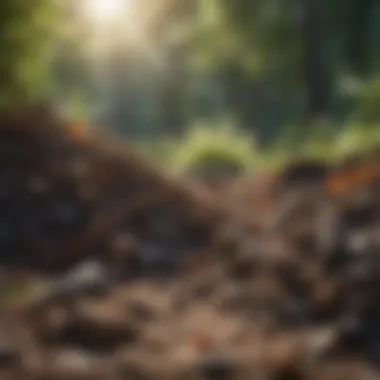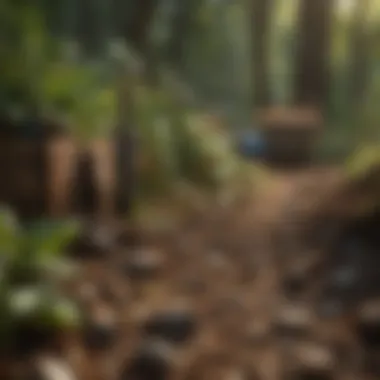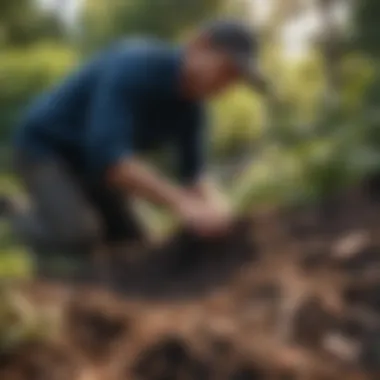Master the Art of Backyard Composting: A Complete Guide for Eco-Enthusiasts


Overview of the Topic
Composting in your backyard is a crucial practice that contributes to sustainable living. By converting organic waste into nutrient-rich soil, you not only support your garden but also reduce the overall waste sent to landfills, minimizing your ecological footprint. This guide will delve into the key aspects of setting up and managing a backyard compost system effectively.
Current Status and Challenges
Currently, many households still dispose of organic waste irresponsibly, leading to increased landfill usage and methane gas emissions. The lack of awareness about the benefits of composting and the misconception of it being challenging are significant hurdles to widespread adoption. Encouraging individuals to embrace composting requires addressing these misconceptions and providing education on the positive impact it can have on the environment.
Sustainable Solutions
To tackle the challenges associated with composting, various sustainable solutions can be implemented. Educating communities about the benefits of composting, providing accessible resources for setting up compost bins, and offering guidance on maintaining a healthy compost pile are crucial steps towards promoting sustainable practices. Successful case studies showcase how communities working together can efficiently manage organic waste and create valuable soil amendments while fostering a sense of environmental responsibility.
Impact and Importance
The impact of backyard composting goes beyond soil enrichment. By diverting organic waste from landfills, composting helps reduce greenhouse gas emissions and minimizes the strain on municipal waste management systems. This shift towards sustainable waste management not only benefits ecosystems by improving soil health but also empowers communities to take ownership of their environmental impact. Conservationists, students, and environmentalists play a vital role in advocating for composting initiatives and highlighting the importance of integrating such practices into daily living for the well-being of current and future generations.
Introduction to Composting
Composting plays a crucial role in sustainable living by transforming organic waste into nutrient-rich soil. This section serves as a foundational exploration of composting, elucidating its relevance and impact on environmental conservation. By delving into the intricacies of composting, readers will gain a profound understanding of how this practice contributes to waste reduction and soil revitalization.
What is Composting?
Composting embodies the natural process of decomposing organic materials to create compost, a valuable soil amendment. The Definition and Concept of composting revolves around the breakdown of organic matter by microorganisms, resulting in a nutrient-dense end product. This eco-friendly practice not only minimizes waste but also fosters healthy soil biodiversity, making it a popular choice for eco-conscious individuals. Composting's unique feature lies in its ability to convert kitchen scraps and yard waste into a beneficial resource, promoting sustainability through resource recycling.
Importance of Composting
The Importance of Composting stems from its multifaceted benefits for both the environment and garden health. Composting facilitates waste diversion from landfills, reducing methane emissions and aiding in soil enrichment. Its eco-friendly nature aligns with the principles of circular economy, wherein organic matter is returned to the earth as a valuable resource. Embracing composting as a lifestyle choice not only nourishes plants through enhanced soil fertility but also fosters community engagement in sustainable practices, making it a pivotal aspect of environmental conservation.
Types of Composting Systems
Vermicomposting
Vermicomposting involves the use of earthworms to accelerate the decomposition of organic matter, enhancing nutrient availability in the resulting vermicompost. This method thrives on the key characteristic of worm castings' richness in essential nutrients, making it a preferred choice for organic gardeners. Its unique feature lies in the symbiotic relationship between worms and microorganisms, yielding nutrient-rich compost for soil health improvement.
Tumbling Bins
Tumbling bins offer a convenient approach to composting with their rotating design, ensuring effective aeration and decomposition of organic materials. The key characteristic of tumbling bins lies in their ability to speed up the composting process through regular turning, making them a popular choice for urban composting. Despite their advantages in space efficiency and odor control, tumbling bins may require additional care in maintaining optimal moisture levels.


Traditional Pile
The traditional compost pile represents a simplistic yet effective method of composting, relying on natural decomposition processes without the need for specialized equipment. Its key characteristic lies in its accessibility and affordability, making it a widely embraced option for backyard composting. While traditional piles offer a low-cost and low-maintenance approach to composting, they may require more time for full maturation compared to other composting systems.
Benefits of Composting
Composting extends a myriad of benefits that contribute to environmental sustainability and soil ecosystem health. By recognizing the Environmental Impact of composting, individuals can mitigate greenhouse gas emissions and promote soil carbon sequestration. Soil Health Improvement is another significant benefit, as compost enriches soil structure and fosters beneficial microbial activity, enhancing plant growth and resilience. Additionally, Waste Reduction through composting diverts organic materials from landfills, conserving limited landfill space and reducing overall waste generation footprint.
Setting Up Your Backyard Compost System
Setting up your backyard compost system is a pivotal aspect of this comprehensive guide. By establishing a robust composting area at home, you can actively contribute to sustainability initiatives and enhance your garden's health. The importance of this topic lies in creating a self-sufficient and eco-friendly solution to managing organic waste, thus reducing the environmental impact of traditional waste disposal methods. Key elements to consider when setting up your compost system include location selection, container choice, and initiating the composting process, all of which play a crucial role in the success of your compost pile.
Location Selection
Sunlight and Shade Considerations
The sunlight and shade conditions of your chosen location significantly influence the composting process. Adequate sunlight is essential for expediting the decomposition of organic materials within the compost pile. On the other hand, shade helps to regulate the temperature and moisture levels, creating a balanced environment for beneficial microorganisms to thrive. Selecting a location that offers a harmonious mix of sunlight and shade is imperative for ensuring the efficient breakdown of organic matter. This balance is key to fostering a healthy compost ecosystem that accelerates the conversion of waste into nutrient-rich soil for your garden.
Proximity to Water Source
The proximity to a water source is another critical consideration when determining the location for your compost system. Easy access to water simplifies the process of maintaining optimal moisture levels within the compost pile. Moisture is essential for enabling microbial activity and facilitating the decomposition of organic material. However, excessive water can lead to anaerobic conditions and unpleasant odors. Finding a suitable location that allows convenient access to water for proper moisture management is indispensable for the success of your composting endeavors.
Choosing the Right Container
When it comes to selecting the right container for your compost system, several factors come into play. Choosing between bins and piles depends on the space available and aesthetic preferences. Bins offer a contained and organized method of composting, keeping the pile neat and manageable. On the other hand, piles are more flexible and suitable for larger quantities of organic waste. Material selection for containers is crucial, with options ranging from wood to plastic, each having unique advantages and considerations.
Bins vs. Piles
The decision between using bins or piles for composting depends on your preference and available space. Bins provide a structured approach to composting, limiting the spread of materials and aiding in temperature regulation. Piles, albeit less visually appealing, offer a simpler and more cost-effective solution for composting on a larger scale. Understanding the benefits and limitations of both options is fundamental in choosing the most suitable container for your specific composting needs.
Material Selection
The choice of material for your compost container influences the overall functionality and longevity of the system. Wood containers are aesthetically pleasing and offer good insulation, maintaining consistent temperatures within the compost pile. Plastic containers are durable and lightweight, making them easy to move and clean. Selecting the right material that aligns with your composting goals and environmental considerations is essential for ensuring the effectiveness and sustainability of your compost system.
Initiating the Composting Process
Initiating the composting process marks the beginning of transforming your organic waste into nutrient-rich compost for your garden. Layering techniques play a crucial role in creating a well-balanced compost pile, ensuring the proper breakdown of materials. Balancing green and brown materials is essential for maintaining the carbon-to-nitrogen ratio, promoting healthy decomposition and preventing unpleasant odors. Mastering these foundational processes sets the stage for a successful composting journey, yielding high-quality compost to enrich your soil and support plant growth.


Layering Techniques
Layering techniques involve alternating green nitrogen-rich materials with brown carbon-rich materials in the compost pile. This strategic layering fosters a symbiotic relationship between different types of organic matter, enhancing microbial activity and accelerating decomposition. Properly layered compost piles provide a diverse environment that encourages the growth of beneficial microorganisms, resulting in faster and more efficient breakdown of materials.
Balancing Green and Brown Materials
Balancing green materials such as kitchen scraps and grass clippings with brown materials like dried leaves and straw is essential for maintaining a healthy compost pile. Green materials supply nitrogen, promoting bacterial growth, while brown materials offer carbon, aiding in moisture retention and aeration. Achieving the right balance between these two types of materials is critical for sustaining the composting process and producing nutrient-rich compost. By understanding the importance of balanced ingredients, you can optimize the decomposition process and create a thriving ecosystem within your compost system.
Maintaining Your Compost
In the realm of backyard composting, maintaining your compost is a crucial aspect that ensures the success and effectiveness of your composting system. Effective maintenance leads to the decomposition of organic matter into nutrient-rich compost that can be used to enrich soil in your garden. By turning and aerating your compost regularly, you facilitate the breakdown of materials and enhance the circulation of air, encouraging the growth of beneficial microorganisms. This section explores the significance of maintaining your compost pile and provides practical insights to help you achieve optimal results.
Turning and Aerating
Frequency and Importance
Turning and aerating your compost heap regularly is essential to ensure that all materials decompose uniformly and efficiently. The frequency of turning your compost depends on various factors such as the size of the pile, the composition of materials, and environmental conditions. By turning the compost, you promote even distribution of moisture, oxygen, and microorganisms throughout the pile, accelerating the decomposition process. The importance of this step lies in avoiding the formation of anaerobic zones, which can lead to unpleasant odors and slow decomposition. Additionally, frequent turning helps maintain proper moisture levels and temperature, creating an ideal environment for microbial activity.
Monitoring Moisture Levels
Signs of Inadequate Moisture
Monitoring the moisture levels in your compost pile is vital to ensure optimal conditions for decomposition. Signs of inadequate moisture include a dry and crumbly texture in the compost, slow degradation of materials, and a lack of earthy smell. Inadequate moisture can impede microbial activity, slowing down the decomposition process. By addressing low moisture levels promptly, you can facilitate the breakdown of organic matter and prevent potential issues like uneven decomposition and pest attraction.
Preventing Over-Watering
On the flip side, over-watering your compost can also be detrimental to the process. Excess moisture can lead to waterlogged conditions, causing anaerobic decomposition and unpleasant odors. To prevent over-watering, ensure proper drainage in your compost pile, monitor moisture levels regularly, and adjust watering practices accordingly. Finding the right balance in moisture content is key to maintaining an aerobic environment that supports the breakdown of organic materials.
Troubleshooting Common Issues
Odor Problems
One common issue that composters may encounter is odor problems arising from imbalanced compost conditions. Odors usually indicate anaerobic decomposition, caused by factors like inadequate aeration or excess moisture. To address odor problems, increase aeration by turning the compost more frequently, adjust moisture levels, and consider adding more bulky materials to improve airflow.
Pest Infestations
Another challenge in composting is pest infestations, which can be attracted to food scraps or improperly managed compost piles. Common pests include fruit flies, rodents, and ants, which can disrupt the composting process and pose health risks. To tackle pest infestations, avoid adding meat or dairy products to your compost, secure the compost pile with a cover or fencing, and regularly turn the pile to discourage pests from nesting.


Harvesting and Using Compost
When it comes to mastering your backyard compost system, the harvest and utilization of compost play a crucial role in the process. Harvesting compost involves recognizing when it is fully composted and ready for use in your garden. This section will discuss the indicators of mature compost and how to best apply it to maximize its benefits for your plants and soil. By understanding the importance of harvesting and using compost effectively, you can close the loop on your sustainable waste reduction practices.
Recognizing Ready-to-Use Compost
Visual Cues
Visual cues are key indicators that your compost is ready for use. These cues include a dark, crumbly texture, earthy smell, and the absence of recognizable organic materials. These characteristics signify that the organic matter has decomposed sufficiently, resulting in nutrient-rich soil amendment suitable for your garden. Visual cues provide tangible evidence of successful composting and signal the optimal time to harvest your compost for gardening needs.
Texture and Smell
The texture and smell of compost are essential factors in determining its readiness for use. Mature compost should have a soft, granular texture that easily crumbles in your hand and emits an earthy aroma. These qualities indicate thorough decomposition of organic materials, ensuring that the compost is packed with essential nutrients for plant growth. By paying attention to the texture and smell of your compost, you can confirm its quality and effectiveness as a natural fertilizer for your garden.
Applying Compost in Your Garden
Benefits for Plants
Utilizing compost in your garden offers numerous benefits for plant health and growth. Compost enriches the soil with essential nutrients, improves soil structure, retains moisture, and promotes beneficial microbial activity. These advantages support robust plant growth, increase crop yields, and reduce the need for chemical fertilizers. Incorporating compost into your garden beds boosts soil fertility and creates a conducive environment for healthy plant development.
Application Tips
Effective application of compost is key to maximizing its benefits in the garden. When applying compost, ensure thorough mixing with existing soil to distribute nutrients evenly. Apply compost as a top dressing or incorporate it during planting to provide immediate nutritional benefits to growing plants. Additionally, consider the specific nutrient requirements of different plant species and adjust the compost application accordingly. By following proper application techniques, you can optimize the impact of compost on plant growth and overall garden productivity.
Storage and Additional Uses
Storing Excess Compost
Proper storage of excess compost is essential to preserve its quality and extend its shelf life. Store excess compost in a cool, dry place to prevent nutrient loss and maintain its beneficial properties. Use airtight containers or bins to shield the compost from moisture and external contaminants. Regularly aerate stored compost to prevent odors and ensure its readiness for future use. By storing excess compost correctly, you can have a sustainable supply of organic fertilizer for ongoing gardening needs.
Compost Tea Recipe
Compost tea is a potent liquid fertilizer that provides plants with a concentrated source of nutrients and beneficial microorganisms. To prepare compost tea, simply steep finished compost in water to extract its nutrients and microbes. Use a brewing bag or container to contain the compost during brewing and aerate the mixture periodically for optimal nutrient extraction. Compost tea can be applied directly to plant roots or foliage as a foliar spray to enhance nutrient uptake and promote plant vitality. By incorporating compost tea into your gardening routine, you can boost soil fertility and plant health naturally.
Sustainable Practices for a Greener Future
Composting as a Lifestyle Choice:
Embarking on a journey towards a more sustainable lifestyle involves making conscious choices that benefit not just oneself, but the environment at large. Composting as a lifestyle choice embodies a profound commitment to reducing waste, enriching soil health, and cultivating a deeper connection with nature. This sustainable practice involves individuals actively participating in the ecological cycle by transforming kitchen scraps and yard waste into nutrient-rich compost, diverting materials from landfills. The central tenet of this choice lies in the inherent symbiotic relationship between humans and nature, where waste is viewed as a valuable resource rather than a burdensome byproduct. Embracing composting as a lifestyle choice translates into a direct contribution to environmental conservation, fostering a mindset of responsibility and resourcefulness. The beauty of this choice lies in its simplicity and accessibility, allowing individuals to play a meaningful role in promoting sustainability within their own homes and communities.
Community Engagement:
Community engagement serves as a powerful catalyst in fostering a culture of environmental stewardship and shared responsibility. By actively involving communities in composting initiatives, the benefits extend beyond individual actions to collective impact, creating a ripple effect of positive change. The key characteristic of community engagement in composting is its ability to unite diverse voices, skill sets, and resources towards a common goal of environmental preservation. Through collaborative efforts, communities can establish shared composting facilities, organize educational workshops, and implement outreach programs to encourage widespread adoption of sustainable practices. This inclusive approach not only cultivates a sense of camaraderie and shared purpose but also amplifies the environmental benefits of composting on a larger scale. The unique feature of community engagement lies in its capacity to foster social cohesion, awareness, and empowerment, transcending individual endeavors to co-create a greener, more resilient future. By harnessing the collective power of communities, composting becomes not just a personal endeavor but a communal endeavor towards building a more sustainable and harmonious world.



